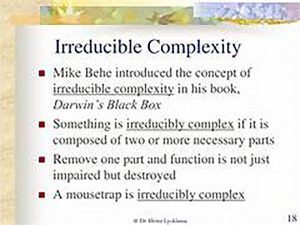by John Richards
Things fester on the internet. Propositions that were refuted long ago don’t go away; there’s always someone who hasn’t been brought up to speed yet, paddling the same old canoe that has already been sunk many times over.
‘Irreducible Complexity’ and ‘Specified Complexity’ are terms used by the proponents of ‘Intelligent Design’ to support their proposition that there is a creator deity. There’s a backstory to this: the Federal government, following a famous 1925 court case, known as the ‘Scopes Monkey trial’ (1), made the teaching of Creationism in US schools illegal. What did the theists do? They rebranded Creationism, calling it ‘Intelligent Design’! At that point they abandoned any claim they might have had to the open mind needed to do science.
‘Intelligent Design’ sidesteps the issue of a Creator God by leaving the agent anonymous. They just refer to an unknown ‘Intelligent Designer’ (we all know they mean their god) and say that the ‘evidence’ for such a being must exist because, they assert, some of the complex features of organisms cannot have evolved. That’s not evidence FOR a designer, it’s just an argument from ignorance fallacy (2) and it reveals that they don’t understand the difference between argument and evidence.
They skate over how one is supposed to recognize what qualifies as a ‘complex feature’ because they obviously wish to extend their claim from ‘a designer must be required for complex features’ to ‘a designer must be required for all features’. They love to quote statistics showing how improbable it would be for things to have evolved by chance. All that does is tell us that they don’t understand how evolution works; the mechanism of evolution is not chance; it’s selection. Leaving all that aside, let’s examine the items of ‘evidence’ that they claim supports their case for an ‘Intelligent Designer’: ‘irreducible complexity’ and ‘specified complexity’.
‘Irreducible complexity’ supposes that certain complex organs or biological processes couldn’t have evolved gradually by intermediate stages because, until they are complete, they don’t work and therefore don’t confer any advantage.

[Ed. Of course a mousetrap is not irreducibly complex. It was designed by a human being. It did not arise by natural selection or God! It was designed in reducible steps.]

The first problem that IDers face is any feature, however complex, is only ‘irreducible’ until it has been shown to be reducible and several of the IDer’s ‘irreducibly complex’ examples have fallen at this hurdle; we have good explanations for how the mammalian eye and the flagellum evolved. Smuggling the assumption of irreducibility into an item being offered as evidence is a clue: it’s not evidence, it’s a claim!
They think like this because they are assuming a deliberate progression from simple to complex. This is not the case; there is no intentionality in evolution, it’s only a matter of passing on genes by not dying before breeding. Sometimes a characteristic begins with one function and, as it evolves, acquires a different function. Evolution is by modification of the existing, not by designing on a blank sheet of paper. Any particular characteristic doesn’t even have to contribute to survival; it might just be taking a ride into the next generation on an individual that didn’t die before breeding for other reasons.
‘Specified complexity’ claims that the existence of coding in the DNA, which instructs the production of proteins that lead to the construction of a cell, indicates that some clever being must have programed it. But both specifying and designing are manifestations of intentional intelligence. Ask any procurement officer and you will find that the first thing they do is compile a wish list of demands – for example: ‘The aircraft should be able to fly at 600mph, carry 300 passengers, have a range of 4000 miles and be able to use short runways’.
Specifications are designed before a product is designed so IDers are assuming the existence of their designer when they label complexity as having been ‘specified’ and then saying that the existence of complex designs proves that there must be a him! All ‘Intelligent Design’ proponents have done is moved their presupposition of a designer back one stage in the process of creation that they imagine is taking place. Projecting backwards is like saying, “I exist, therefore, two hundred years ago, my great, great, great, great, great, great, great, great, great grandfather must have inseminated his partner with a plan to produce me as a descendant!” Ludicrous isn’t it! You can’t conclude historic intentionality; it will always be merely a claim.

Once you spot that specifying is designing, their claim boils down to ‘designed complexity is evidence of a designer’! They are just trying to trick us by using the word ‘specified’ instead of the word ‘designed’. This is an example of the ‘begging the question’ fallacy or circular reasoning (3) – assuming an explanation for an existing phenomenon and then claiming that the existence of the phenomenon is evidence for that assumption! Smuggling the assumption of specification (designing the features) into an item being offered as evidence for design is a clue: it’s not evidence, it’s a claim!
The fact is, biological diversity doesn’t require any specifying. We understand how the complexity of DNA came about and it wasn’t by design, it was by natural selection from an array of variants produced by mutation, both of which are unplanned events. Variants pop up all the time due to external mutagenic factors and recombinations in the gametogenesis and fertilization processes. That happens continuously, whether the species is evolving or not. The environment determines which variants succeed and has its ‘foot on the throttle’: more change in the conditions stimulates more change from the population in response. No need for any specifier, designer or god.
Then there are the countless examples of unintelligent ‘design’! Once you actually study genetics you will find lots of apparent nonsense, such as multiple replications of pieces of code and dormant viruses, in every nucleus. Craig Ventner has demonstrated this with the investigation to find the minimal genome (4). The truth is, we have acquired a hotch-potch of accidentally accumulated genetic material which is most unlike any deliberately specified code. A designer would have to have been a scatterbrain rather than intelligent.
IDers are not doing science; they are doing presuppositionism and the law courts agree: ‘Intelligent Design’ was recognised as Creation by another name in the 2005 case of Kitzmiller versus Dover Area School District (5).
Even if ‘irreducible complexity’ and ‘specified complexity’ were real things, they wouldn’t be evidence for an Intelligent Designer, they would just be unsolved mysteries. You can’t turn ‘we dunno’ into ‘godunnit’. Not even any god, let alone the Christian one… This is Science 101. Go back to school IDers.
References:
1. https://en.wikipedia.org/wiki/Scopes_Trial
2. https://en.wikipedia.org/wiki/Argument_from_ignorance
3. https://en.wikipedia.org/wiki/Begging_the_question
4. https://en.wikipedia.org/wiki/Minimal_genome
5. https://en.wikipedia.org/wiki/Kitzmiller_v._Dover_Area_School_District



Pingback: Irreducible and Specified Complexity - Loon Registrar